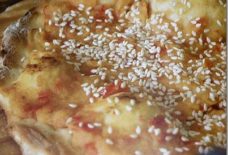NY Times: Tahini, The Taste of Healthy Middle Eastern Cuisine
When I come home hungry from a late afternoon swim, my idea of a perfect snack is a piece of toast topped with sesame tahini, a paste made from lightly toasted hulled sesame seeds. It’s very satisfying, lighter than bread topped with almond butter or peanut butter. It’s a healthy snack, too: sesame seeds contain copper and manganese, as well as calcium, iron, vitamin B1 and dietary fiber.
Sesame has been cultivated for longer than any other seed, according to nutritionist and author Jonny Bowden. While Asian sesame paste is made with unhulled seeds, the Middle Eastern paste is made with hulled seeds. It has a mild, nutty flavor and a wonderful creamy (bordering on runny) texture. An essential ingredient in many signature Middle Eastern dishes, among them hummus and baba ganoush, tahini is also the main ingredient in pungent dipping sauces served with falafel, keftes and vegetables.
As sesame tahini sits, the oil separates, so the mixture should be stirred before it’s used. Sesame tahini should be slightly runny — virtually all of the imported brands that I use have this consistency, but domestic versions can be thick and pasty, and a bit flavorless. You can find imported tahini in Mediterranean markets and in many grocery stores. It must be stored in the refrigerator once opened.
Baba Ganoush
Baba ganoush is a signature Middle Eastern grilled eggplant puree enriched with tahini and seasoned with lemon juice and lots of garlic. The dish has a smoky, pungent flavor. Don’t forget to pierce the eggplant before you put it on the grill. You can also grill it inside over a gas flame.
2 pounds eggplant, preferably small eggplants
1/4 cup freshly squeezed lemon juice (more to taste)
1/4 cup sesame tahini, stirred if oil has separated out
1 to 2 tablespoons plain low-fat yogurt, as needed
2 garlic cloves, cut in half, green shoots removed
Salt to taste
For garnish:
Extra-virgin olive oil
Chopped flat-leaf parsley
1. Prepare a hot gas or charcoal grill. Pierce the eggplants in several places with a fork or the tip of a knife, and place over the hot coals. Grill, turning regularly, until soft and blackened all over. If you don’t have a grill but do have a gas stove, preheat the oven to 425 degrees. Cover the top of your stove under the burner grates with foil to facilitate cleaning. Turn on your oven fan (so the smoke alarm won’t go off), and roast the eggplants directly over the flame, turning often until charred and softened. Small, thin eggplants will cook through this way, but larger eggplants must be finished in the oven. Wrap in foil, and place in the hot oven for 20 minutes until thoroughly softened. You can also roast the eggplant under a broiler until charred and softened. The flavor of the baba ganoush will not be as smoky.
2. Place the grilled eggplant in a colander in the sink, and allow to cool and drain. Peel and discard the black skins, cut off the stems, and let the eggplants sit in the colander to drain for another 15 to 30 minutes.
3. Puree the eggplant in a food processor fitted with the steel blade. Add the lemon juice, yogurt and tahini. In a mortar and pestle, pound the garlic to a paste with a generous pinch of salt. Add to the food processor, and blend with the eggplant. Add salt to taste.
4. Mound the puree in a bowl or on a platter, and drizzle with olive oil. Sprinkle with parsley. Serve with pita bread.
Yield: About 2 cups.
Advance preparation: This dish can be made several hours ahead. The flavors are best on the day it’s made, as the garlic, lemon juice and eggplant become more pungent over time.
Martha Rose Shulman
New York Times


